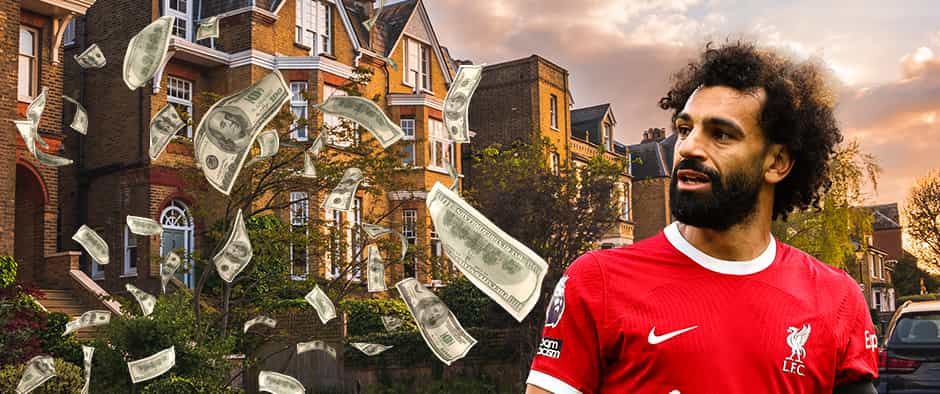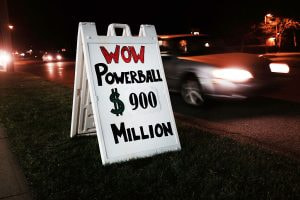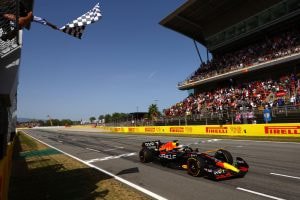Football Wages vs. Home Prices: An Eye-Opening Comparison
Everyone knows footballers earn a lot of money, and I mean a lot! The average Premier League footballer earns in a week, much more than most of us earn in a year. And the top players’ wages are much higher, earning more in a year than most of us could make in several lifetimes. In this article, I’ll compare the top footballers’ salaries with the most significant expense we have ever faced: purchasing a house.

When the top-tier English football league, which had existed from 1888 until 1992, was re-branded as the Premier League, very few realised the impact that this change would have domestically and worldwide.
In a few short years, with the broadcasting might of Sky behind it, the Premier League became the powerhouse of club football.
The first TV rights package sold to broadcasters was worth £304 million over five seasons. Fast forward 30 years, and the deal’s value is now worth an astonishing £4.464 billion.
However, the games are not just broadcast to the UK. Fixtures are also shown live in these regions – Asia, Australia, Indian Subcontinent, MENA region, China, Canada, United States, sub-Saharan Africa, continental Europe, France, Germany, Austria, Russia, Italy, Portugal, Spain, Turkey, Romania, Indonesia, Malaysia, Nordic countries (Sweden, Denmark, Norway), Poland, Netherlands, South America, Brazil, Central America.
These commercial deals bring even more money in for the Premier League. The NBC deal alone (USA), which runs until 2028, is worth £2 billion, and much of the money ultimately finds its way into the pockets of the footballers who play for Premier League clubs.
| Highest Paid Premier League Players by Season | |||
|---|---|---|---|
| Year | Player | Weekly Wage | Team |
| 1992/93 | John Barnes | £10,000 | Liverpool |
| 1993/94 | John Barnes | £10,000 | Liverpool |
| 1994/95 | Eric Cantona | £18,000 | Manchester United |
| 1995/96 | Dennis Bergkamp | £25,000 | Arsenal |
| 1996/97 | Fabrizio Ravanelli | £42,000 | Middlesbrough |
| 1997/98 | Alan Shearer | £34,000 | Newcastle United |
| 1998/99 | Alan Shearer | £34,000 | Newcastle United |
| 1999/00 | Roy Keane | £52,000 | Manchester United |
| 2000/01 | Roy Keane | £52,000 | Manchester United |
| 2001/02 | Roy Keane | £90,000 | Manchester United |
| 2002/03 | Roy Keane | £90,000 | Manchester United |
| 2003/04 | Hernan Crespo | £94,000 | Chelsea |
| 2004/05 | Frank Lampard | £98,000 | Chelsea |
| 2005/06 | Steven Gerrard | £100,000 | Liverpool |
| 2006/07 | Andriy Shevchenko | £118,000 | Chelsea |
| 2007/08 | John Terry | £135,000 | Chelsea |
| 2008/09 | Robinho | £160,000 | Manchester City |
| 2009/10 | Carlos Tevez | £250,000 | Manchester City |
| 2010/11 | Carlos Tevez | £250,000 | Manchester City |
| 2011/12 | Carlos Tevez | £250,000 | Manchester City |
| 2012/13 | Carlos Tevez | £250,000 | Manchester City |
| 2013/14 | Wayne Rooney | £300,000 | Manchester United |
| 2014/15 | Wayne Rooney | £300,000 | Manchester United |
| 2015/16 | Wayne Rooney | £300,000 | Manchester United |
| 2016/17 | Wayne Rooney | £300,000 | Manchester United |
| 2017/18 | Alexis Sanchez | £350,000 | Manchester United |
| 2018/19 | Alexis Sanchez | £350,000 | Manchester United |
| 2019/20 | David de Gea | £375,000 | Manchester United |
| 2020/21 | David de Gea | £375,000 | Manchester United |
| 2021/22 | Christiano Ronaldo | £510,000 | Manchester United |
As you can see from the table above, the wages paid to Premier League stars have skyrocketed. When the fledgling league started, John Barnes was the first player to earn £10,000 weekly.
Happy 60th Birthday to the legend John Barnes 🎉
Poise, pace, strength and skill. He had it all 🔥 #LFC @officialbarnesy pic.twitter.com/qWGiWkXIxO
— TheKop.com (@TheKop_com) November 8, 2023
Fast forward 31 years, Christiano Ronaldo’s deal with Manchester United saw the veteran earn £510,000, a 51-x increase. Ronaldo earned in a week the amount that John Barnes earned in an entire year.
The average house price in the UK in 1992 was £52,187. If Barnes had wanted to invest every penny into buying property, if we ignore the fact that he would be paying taxes, his £520,000 a year salary would have enabled him to buy almost ten houses (9.96). In Q4 2022, the average house price in the UK was £258,115. If we do the same calculation, Ronaldo, winner of five Ballon d’Or titles, earned a total of £26,520,000, enough for 102 houses (102.74).

As you can see from the detailed infographic above, which shows the highest earners at each club, modern day footballers earn an astromical amount of money. However, as the house prices vary throughout the country, some players can afford more property for their money than others.
Premier League Wages – The North
You may have heard the expression, “It’s grim up North”, but does that ring true if you are a Premier League player?
The North has been a powerhouse of football since top-flight football existed, and the two most successful teams in regard to league titles are Manchester United and Liverpool.
Manchester United won their first title in the 1907/8 season and went on to claim 20 titles and 17 runner-up awards. Liverpool won their first title even earlier (1900/01) are just one behind on 19 titles overall, and have been runner-up on 15 occasions.
Everton and Manchester City are the other “Up North” clubs that have enjoyed success. Everton’s nine titles have been spread out since their first win in 1891 and their last in 1987, while out of Manchester City’s nine, seven have all come since 2012.
Newcastle United, a club with a storied past, has long been estranged from the taste of victory.
As they’re affectionately known, the Magpies last clinched the old First Division title in the distant years of 1905, 1907, 1909, and 1927. Their triumphs in the FA Cup, totalling six, are similarly enshrined in history, with the most recent in 1955 (preceded by wins in 1910, 1924, 1932, 1951, and 1952). Only the most senior of fans might recall these moments of glory, as they’ve become faded memories in football history.
However, the club has new owners, with the Saudi Arabians buying the club for £305 million, ending Mike Ashley’s often torturous 14-year tenure as the proprietor of Newcastle United. The primary financier, the Public Investment Fund (PIF), which contributed 80% of the capital for the acquisition, is regarded as an entity distinct from the Saudi state. However, that is a different conversation altogether, as you’ll be hard-pressed to find many people who believe that.
One thing that is not in doubt is that with PIF’s assets amounting to £250 billion, Newcastle United now ranks among the wealthiest clubs globally.
Amanda Staveley, the financier at the forefront of the consortium, has declared that the new proprietors are committed to a “long-term investment” strategy to propel Newcastle to “consistently vie for major trophies” and many pundits agree that it is only a matter of time before the Toon Army are celebrating a trophy. Newcastle came close to winning the Carabao Cup (League Cup), but were beaten 2-0 in the final at Wembley by Manchester United.
Amanda Staveley cheered as she makes her way off the pitch and into the stands #NUFC #NUWFC pic.twitter.com/bc51wEtBG6
— Aaron Hindhaugh (@AHindhaugh98) November 5, 2023
To answer the question, “is it grim up North”, the simple answer is not if you are a top player at a Premier League club, as those players earn some of the highest wages in England.
| Player Financials and Local Housing Affordability | ||||
|---|---|---|---|---|
| Player | Est. Annual Salary | Club | Local House Price | Number of houses affordable |
| Mohamed Salah | £18,200,000 | Liverpool | £161,000 | 113.04 |
| Kevin De Bruyne | £20,800,000 | Man City | £231,000 | 90.04 |
| Casemiro | £18,200,000 | Man Utd | £360,000 | 50.56 |
| Bruno Guimarães | £8,320,000 | Newcastle | £182,500 | 45.59 |
| Jordan Pickford | £6,500,000 | Everton | £161,000 | 40.37 |
Mo Salah, a firm favourite when football betting at UK betting sites, leads the way, and his salary of £18,200,000 (which equates to £350,000 per week) is enough for the ‘Egyptian King’ to purchase 113.04 houses per year.
Kevin De Bruyne, on £20,800,000 (£350,000 per week), earns more than the Liverpool winger, but Salah is able to take advantage of cheaper housing in Liverpool compared to Manchester. The average house price in Liverpool is £161,000, 30.3% cheaper than the £231,000 that De Bruyne needs to pay per house.
Child poverty campaigner Marcus Rashford earns a tidy sum, too. The Manchester United man was approaching the end of his previous contract and had to fend off reputed interest from clubs abroad, such as PSG. The 26-year-old is now reputedly earning £300,000 a week. Rashford was awarded an MBE in the former Queen’s Birthday Honours list for his contributions to aiding vulnerable children in the UK throughout the Covid-19 pandemic. His campaigning led to the UK government reversing a decision to suspend payment to families for meals during school holidays.
Although I, of course, applaud Rashford for his work in raising awareness of child poverty, it is only fair to point out that the Manchester United academy product earns an eye-watering amount of money.
It costs the UK government £2.41 per meal for younger children and about £2.47 for older ones. According to official statistics, Almost 20% (19.7%) of pupils were eligible for free school meals, amounting to 1,633,698. Therefore, the cost per week is £4,002,560.
Marcus Rashford’s salary at Manchester United is £300,000 per week, enough to pay for 125,000 free school meals. Alternatively, he could solve the housing crisis in Trafford.
I’m mystified as to why a ‘poverty campaigner’ doesn’t merely own a £700,000 Rolls-Royce but owns a £600,000 ‘back up’ one in case he crashes his first (which he has). We’ve all heard of champagne socialists, but this is next level. Rolls-Royce Radicals? https://www.dailymail.co.uk/sport/football/article-12557899/Marcus-Rashford-arrives-Man-United-training-spare-600-000-Rolls-Royce-crashing-one-car-driven-74-year-old-grandmother-winning-Burnley-Saturday-night.html
— Toby Young (@toadmeister) September 25, 2023
The average house price in Trafford (the 41 square miles that includes Altrincham, Stretford and, of course, Old Trafford) is £360,000. That means Rashford could buy 40 houses in a year and still have £1,198,800 left, enough for 193,354 portions of fish & chips (£6.20) at Charlie’s Fish & Chips shop in Urmston.
Rashford’s rival, Erling Haaland plays his football four miles away at the Etihad Stadium for Manchester City. That four miles make quite a difference in house prices.
The average house price in the Greater Manchester area is £231,000, compared to £360,000 in Trafford, a 35.83% difference. As Haaland also earns more (£375,000 per week, compared to £300,000) and the houses are cheaper, Haaland could potentially buy 84.42 houses per year, almost double the number of Rashford (43.33).
The property market, in particular, feels the impact as footballers, as we know from their socials, tend to purchase some of the most lavish homes on the market. This purchasing drives up property values. This trend often leads to a ‘footballer’s row,’ where a single street or area becomes synonymous with luxury living. One of the most famous examples of this is in Cheshire.
Can tell I'm back in chesh, every other car is a Bentley. Hello millionaires row… #home #cheshire #rich #millionaire
— Emma Finney (@LilFinney) October 12, 2012
Stars from Manchester United and City, including Raheem Sterling, John Stones, Kyle Walker, Harry Maguire, Marcus Rashford, and Luke Shaw, along with Liverpool and Everton’s Jordan Pickford and Jordan Henderson, reside in the affluent Cheshire Golden Triangle or grand estates nestled within picturesque hamlets like Knutsford.
Premier League Wages – The Midlands
The Midlands are relatively unrepresented in the Premier League, with just two clubs from the heart of England playing top-flight football, Aston Villa and Wolverhampton Wanderers.
Wolves was founded in 1877 as St Luke’s FC by pupils of a school in Blakenhall, Wolverhampton. The club merged two years later with the local cricket and football club The Wanderers, hence adopting its current name.
They were one of the founding members of the Football League and have won the First Division three times ) 1953–54, 1957–58 and 1958–59) and the FA Cup four times (1892–93, 1907–08, 1948–49 and 1959–60). Their best season in Europe came in 1972 when they were beaten 3-2 by Tottenham in the final of the UEFA Cup (the equivalent of the UEFA Europa League.
🗓️🏆 #OnThisDay in 1972, we beat Wolves to win the UEFA Cup!#THFC ⚪️ #COYS pic.twitter.com/CudeP8rRkx
— Tottenham Hotspur (@SpursOfficial) May 17, 2019
Wolves local rivals Aston Villa were founded in 1874 by members of the Villa Cross Wesleyan Chapel in Aston. The club played a mix of rugby and football rules in the 1870s before becoming a key part of the newly formed Football League in 1888. They have the bragging rights in the Midlands, winning seven League Championships (1894, 1896, 1897, 1899, 1900, 1910 and 1981), seven FA Cups (1887, 1895, 1897, 1905, 1913, 1920 and 1957) and five EFL Cups (1961, 1975, 1977, 1994 and 1996).
The Villa have also had more success in Europe, winning the European Cup (equivalent to the Champions League) in 1982 and the European Super Cup the following season by beating the mighty Barcelona 1-3 on aggregate. They lost 1-0 at the Camp Nou in Barcelona in the first leg but triumphed 3-0 at Villa Park.
Neither club has enjoyed domestic success in recent years, and their commercial income is not on par with clubs to the North and South of them; their ability to pay big wages is somewhat hindered.
That’s not to say the players are struggling financially; far from it, as the top earner at Aston Villa earns £225,000 per week and £195,000 at Wolves.
With the average wage for the Midlands being £26,530, a top earner at both clubs makes in a week what the average person earns in a decade.
Also worth considering is that house prices in the Midlands are favourable, costing an average of £225,000 in Birmingham (Aston Villa) and £195,000 in Wolverhampton. This figure is slightly lower than the £231,000 in Manchester and much lower than the £770,000 for the Chelsea and Kensington districts.
| Player Financials and Local Housing Affordability | ||||
|---|---|---|---|---|
| Player | Est. Annual Salary | Club | Local House Price | Number of houses affordable |
| Youri Tielemans | £7,800,000 | Aston Villa | £225,000 | 34.67 |
| Pablo Sarabia | £4,680,000 | Wolves | £195,000 | 24.00 |
As you can see from the table above, Youri Tielemans’ £7,800,000 is enough to buy 34 houses a year and still have £150,000 for a trip or two to IKEA. Although Pablo Sarabia can take advantage of the £30,000 saving per house in Wolverhampton, his wages are also £30k lower, meaning he can buy 24, ten less than Tielemans.
Premier League Wages – The South
Although Northern teams have monopolised league titles over the last five years, Southern teams make up the majority of teams competing in the league.
Arsenal, Bournemouth, Brentford, Brighton, Chelsea, Crystal Palace, Fulham, Luton, Tottenham and West Ham are all members of the elite Premier League.
Arsenal leads the pack in terms of title wins with 13 and have been runners-up ten times. Their modern league triumphs came under Arsene Wenger. Arguably one of the finest managers of all time, he took over the Gunners in 1996 and led them to three titles (1997–98, 2001–02 and 2003–04). The 2003-04 title was exceptional as they went all season unbeaten, earning the title “The Invincibles”.
𝐀𝐧𝐝 𝐬𝐭𝐢𝐥𝐥.
Arsenal 2003-04 are the Premier League's only Invincibles 😏 pic.twitter.com/AoBw6oKESX
— B/R Football (@brfootball) November 6, 2023
Chelsea had only won one title (1954–55) before a certain Russian named Roman Abramovich took control of The Blues. Under his guidance (and chequebook), Chelsea won a remarkable 18 major trophies, a feat matched only by Manchester United in the same period. Their haul included two UEFA Champions League titles, two UEFA Europa League crowns, a pair of UEFA Supercups, and a quintet of Premier League triumphs (2004–05, 2005–06, 2009–10, 2014–15 and 2016–17).
Significantly, 2010 saw the club clinch its first league and FA Cup double. Chelsea’s trophy cabinet also boasts five FA Cups and three League Cups during this era, marking them as one of England’s most triumphant teams.
The only other league winners from “down South” are Tottenham, who won the old First Division in the 1950–51 and 1960–61 seasons.
Although Spurs have enjoyed cup success, winning the FA Cup eight times (1900–01, 1920–21, 1960–61, 1961–62, 1966–67, 1980–81, 1981–82 and 1990–91), the League Cup four times (1970–71, 1972–73, 1998–99 and 2007–08) and the UEFA Cup Winners’ Cup (1962–63) and UEFA Cup twice (1971–72, 1983–84), the closest they have come to winning the league again was in the 2016–17 season when their 68.42% winning rate was only good enough for second place. To rub salt into the wounds, it was their city rivals, Chelsea, who finished above them.
| Player Financials and Local Housing Affordability | ||||
|---|---|---|---|---|
| Player | Est. Annual Salary | Club | Local House Price | Number of houses affordable |
| Raheem Sterling | £16,900,000 | Chelsea | £770,000 | 21.95 |
| Kai Havertz | £14,560,000 | Arsenal | £657,500 | 22.14 |
| Heung-min Son | £9,880,000 | Tottenham | £585,000 | 16.89 |
| Ansu Fati | £8,320,000 | Brighton | £439,750 | 18.92 |
| Lucas Paquetá | £7,800,000 | West Ham | £435,000 | 17.93 |
| Raúl Jiménez | £5,200,000 | Fulham | £770,000 | 6.75 |
| Michael Olise | £5,200,000 | Crystal Palace | £430,000 | 12.09 |
| Justin Kluivert | £4,160,000 | Bournemouth | £343,000 | 12.13 |
| Ben Mee | £2,860,000 | Brentford | £490,000 | 5.84 |
| Albert Sambi Lokonga | £2,600,000 | Luton | £310,000 | 8.39 |
As you can see from the table above, Raheem Sterling leads the earnings table for the Southern clubs. The 28-year-old has the unique distinction of having played for three of the so-called ‘big six’. The striker started at Liverpool, moved to Manchester City and then moved on to Chelsea in a surprise transfer in the summer. As a result, he is on massive wages, pocketing £16,900,000 a year (£325,000 per week).
Unfortunately for Sterling, if he decided to splash his cash on local houses around Stamford Bridge, his money wouldn’t go as far as for other players. The average house price in Chelsea is £770,000, a whopping 563.79% higher than the average that the Burnley players need to pay (£116,000).
However, let’s not feel too sorry for Raheem, as he could still afford to buy almost 22 houses yearly (21.95).
Kai Havertz, who plays his football just 5.59 miles away, is the second-highest earner on the list, earning £2,340,000 less than the Englishman. However, as the average house price in Arsenal is £112,500 cheaper, the German can afford slightly more houses (22.14).
Raúl Jiménez, the Fulham player, is on £5,200,000, enough to buy 6.75 houses as the property prices are the same as in Chelsea.
Raul Jimenezpic.twitter.com/0ldRi3aLu5
— RJ32 (@ktp_fcb) November 8, 2023
Brentford player Ben Mee is the highest earner who can afford the least number of houses. His relatively low salary (for a Premier League footballer) of £2,860,000 (£55,000 per week) and the £490,000 average house price in Brentford, means he can “only” buy 5.84 houses per year.
Football Wages vs. Home Prices – Final Thoughts
The extraordinary salaries commanded by Premier League footballers, set against the backdrop of escalating housing costs in England, paint a captivating yet somewhat troubling picture.
Tracing back to the early stages of the Premier League, where a leading player’s weekly remuneration was comparatively reasonable considering the money in the game, we have witnessed an exponential increase to today’s staggering sums. The stratospheric earnings of stars like Kevin De Bruyne, who can buy more than a hundred dwellings annually, underscore the pronounced economic chasm in contemporary society.
This gulf is further accentuated when one considers housing affordability across various regions. Elite players in the North and Midlands may comfortably acquire numerous properties yearly. Yet, their southern counterparts encounter more prohibitive property values, diminishing their buying capability, albeit vastly exceeding that of the average person.
The English average wage is £38,600, and the average house price is £258,115, meaning it would take 6.68 years for a person to buy a house in the improbable scenario that they could use all their wages to complete the purchase (and not pay any tax, National Insurance, council tax or any bills during that time).
House prices in the UK are the as they were in 2012, it's only inflation that has gone up. pic.twitter.com/RgbYB006Uu
— Brett Jones (@BrettJ87543) November 11, 2023
The ramifications of these inflated wages extend beyond the players, influencing the housing market and frequently elevating prices in locations favoured by footballers.
Furthermore, the societal contributions of footballers, as seen by Marcus Rashford’s laudable endeavours in combating child poverty, demonstrate the far-reaching influence of these sportsmen. Their considerable economic power, when directed positively, can effect meaningful change in urgent societal issues.
At its core, the Premier League represents a microcosm of broader economic patterns, characterised by pronounced disparities in wealth and income. As the league expands in popularity and fiscal strength, this examination serves as a poignant reminder of the distinctive economic sphere within which elite football operates and the intricate interplay among sport, society, and the economy.
*Football player salary information was taken from transfermarkt.com. Houses prices are based on the average house price in the council borough in which the football stadium is based in. All information is correct at time of writing, but may fluctuate over time.



